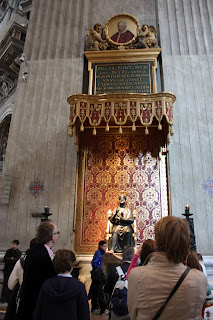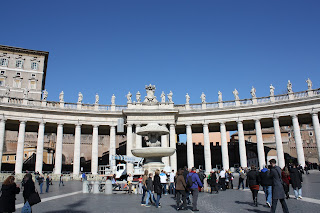The day after we got back from Sicily, I had a nice surprise waiting for me-a beautiful bouquet from Kyle!
 |
| Valentine's bouquet from Kyle |
The next weekend I went on a weekend trip to Naples. The night before we left, it decided to snow in Rome. And just so you know, whenever snow is even in the forecast, the entire city shuts down...
 |
| View out our living room window-a cactus in the snow! |
Luckily the trams were running that morning so we could get to the train station on time.
 |
| Viale de Trastevere in the snow |
When our train arrived in Naples, it decided to start raining just at that very moment. We started making our trek which should have only been 20 minutes, however, Joe (the only guy in our group...) had to stop in every single shoe store until he found the exact pair of shoes he had been looking for. Two of the girls had already gotten to Naples the day before and were waiting for us at the hostel when we got there.
 |
| Julia Roberts at Pizzeria da Michele |
As soon as our stuff was put down they took us to the place where pizza margherita was said to be invented! This place is of course the place where Julia Roberts goes in the movie
Eat, Pray, Love which is called Pizzeria da Michele.
 |
| Fanta in a glass bottle! |
There are two options for pizza here: marinara or margherita. That's it, so you better like one of them. Of course we all got the margherita pizza because who doesn't love cheese?
 |
| Pizza Margherita |
One thing was for certain-this was definitely some of the best pizza I have ever had!
 |
| Sarah, Yasmine and Maggie with one of the pizza chefs! |
The staff was really great too, one of them took a picture of our group and then wanted to jump in one himself! They also didn't really have waiters, whenever one of the pizzas was done, one of the chefs would just bring it out.
 |
| Photo of Julia Roberts!! |
The also have a few awards hanging on their wall along with photos of Julia Roberts!
 |
| Magical pizza oven |
 |
| Hard at work... |
After pizza, we went to the museum which displays some of the artifacts that were savaged from the ruins of Pompeii.
 |
| Frescoes |
These are some of the frescoes that were found in some of the houses.
 |
| Mosaics |
Pompeii was known as having a very rich society and had many nice things as well as lavishly decorated houses.
 |
| Bronze pieces found |
The museum itself was also impressive. We all loved this grand staircase leading to the upper floors...
 |
| Elaborate staircase |
...and the amazing ceiling in the room when we entered. The room was entirely empty except for paintings hung on the walls.
 |
| Marvelous frescoed ceiling |
Before heading back to our hostel, we went through the Gallery which is basically a big enclosed shopping mall.
 |
| Galleria |
Once we got back we got ready for our night at the opera!! The outside of the building wasn't that great but the inside was spectacular!
 |
| Hallway leading to our private box! |
Of course we could only afford the cheap seats but that was okay for us because we ended up having our own private boxes!! Sarah and I were in one and Yasmine and Christianne were in one right beside us.
 |
| Our private box! |
We had a great view of the opera house from where we were!
 |
| Main seats |
 |
| Stage |
 |
| Stage decorations |
 |
| Lights |
 |
| The best seats were in this ornamented box |
 |
| Painted ceiling |
 |
| Floor seating |
 |
| My pretty hair barrette |
 |
| Sarah looking out of our box |
The best part was that just before the show started, the doorman came and got us and moved us down to floor seats because they wanted the floor to be pretty much full for the performers.
 |
| Painted ceiling from floor seats |
Floor seats for the price of the nose bleeds? Deal!!
 |
| Stage from floor seats |
The story line for the opera was based off of Romeo and Juliet. Even though we couldn't understand it, it was still fantastic!
__________________________________________________________________________________
The next day we took a train to Pompeii to look at the ruins.
 |
| Temple area |
We were all amazed at how well everything was preserved.
 |
| Composite Columns |
I guess being covered in volcanic ash for 1700 years had something to do with it.
 |
| Public square |
Floor mosaics seem to have been untouched by age.
 |
| Floor mosaics |
Even some of the frescoes on the walls are still there.
 |
| Preserved frescoes |
 |
| Atrium courtyard |
We were amazed at what still existed. The ancient streets were still visible which were once lined with houses.
 |
| Ancient street lined with houses |
The large theater was still mostly intact along with some of the smaller theaters in the city.
 |
| Large theater |
Pompeii even had it's own stadium.
 |
| Stadium |
 |
| Tunnel to floor of stadium |
 |
| Interior of stadium |
 |
| Another ancient street |
Then we came upon the volcano itself-Mt. Vesuvius. Unfortunately, we didn't get a chance to go up because it was raining all day and we didn't feel like hiking in it.
 |
| Mt. Vesuvius |
The main museum was closed for the season but there were a few plaster molds out on display.
 |
| Plaster mold of body found |
Later that afternoon, we headed back to Naples before catching our trip back to Rome! Even though this was a quick trip, it was very enjoyable!
 |
| Castle near our hostel |






























































